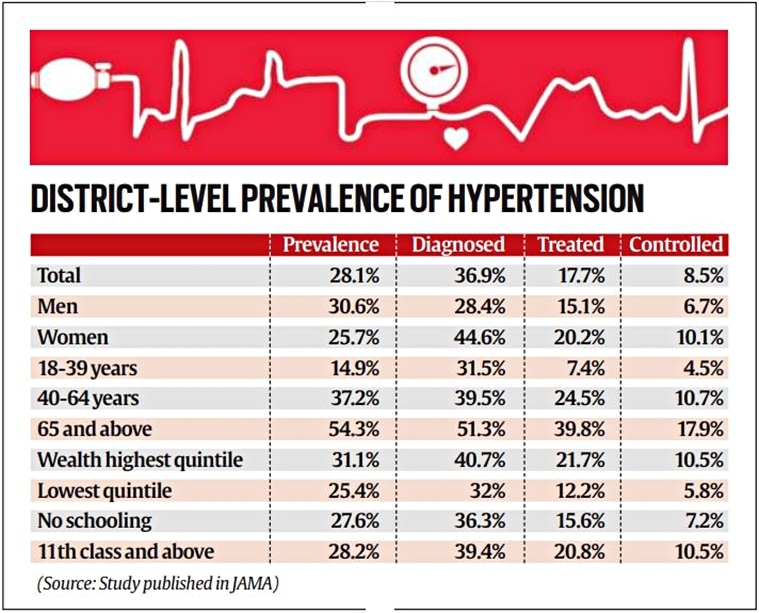There is a significant variation in the level of prevalence, diagnosis, treatment, and control of hypertension within Indian states, and even within districts in states, an analysis of the recent National Family Health Survey data published in the journal JAMA said.
The researchers said that the national mean values of hypertension “hide considerable” variation at the district level, and recommended “targeted, decentralised solutions.”

What does the study tell us about hypertension care in India?
The national-level data shows what doctors across the country already know — a larger number of those with hypertension do not get diagnosed; among those who get diagnosed, many do not initiate treatment; and among those who do initiate treatment, few are able to control their blood pressure. Only one in three receives a diagnosis, one in five gets treated, and one in twelve achieves blood pressure control.
The interesting find is the inter-state and inter-district variability of the levels of continuum of care.
At state level
The study found that the prevalence of hypertension was similar among the southern states but it was higher than the national average — 29.9% of the population in the southern states as compared with 26.8% across India.
The proportion of people diagnosed with hypertension in the southern states was similar to the rest of India, but the proportion of people on treatment and under control was higher in these states, the study showed.
At district level
Not only at the state-level, there were significant variations within states as well. The researchers cited the example of two states to demonstrate this.
Story continues below this ad
In Meghalaya, the prevalence of hypertension was similar in the districts of Garo Hills (21.8%), Jaintia Hills (19.8%), and Khasi Hills (23.1%). However, the proportion of those diagnosed was lower in Garo Hills at 18.6% as compared with 29.4% in Khasi Hills and 41.1% in Jaintia Hills.
In Karnataka, four districts — Chikmagalur, Shimoga, Udupi and Chitradurga — have a similar prevalence of hypertension, but the proportion of people who received treatment and successfully controlled it was higher in Chikmagalur and Udupi.
 The district-level break-up of data can help state governments plan where and which level of care needs more resources (Express)
The district-level break-up of data can help state governments plan where and which level of care needs more resources (Express)
What’s the impact of age, gender, and education?
Even at the national level, there were significant variations in the levels of continuum of care depending on the gender, age, socio-economic conditions, and education level of the person.
Story continues below this ad
While it is well-known that men are more likely to have hypertension than women, surprisingly, the data show that women are much more likely to be diagnosed, be on treatment, and have their blood pressure under control.
The prevalence, diagnosis, treatment, and control were all higher among those over the age of 65 years when compared with youngsters. When it comes to socio-economic conditions, the prevalence, diagnosis, treatment, and control of hypertension were found to be highest among the wealthiest fifth of the population.
While the prevalence of hypertension was similar among those who had had no schooling and those who had passed Class 11, diagnosis, treatment, and control was higher among those who had completed schooling.
Why look at inter-state and inter-district variability?
This district-level break-up of data can help state governments plan where and which level of care needs more resources, said Dr Nikhil Tandon, one of the authors of the paper and professor of endocrinology and metabolism at the All India Institute of Medical Sciences, Delhi.
Story continues below this ad
He said: “It is essential that healthcare systems are planned differently for the management of chronic conditions like hypertension than for acute diseases. For an acute disease, the patient is likely to seek out care, and the treatment is also finite. Once they seek care and are prescribed medicines, they are likely to take it for the recommended duration because they want to feel better. But we know this does not happen with hypertension.”
Take, for example, a district where medicines are not available at regular intervals. The local government then has to ensure that the medicines are available regularly and at centres close to people’s homes. Or, a push towards digitisation of records is needed, which can help health workers ensure regular follow-ups and stock-taking of medicines.
For hypertension, Dr Tandon said, continuum of care, and not just screening and diagnosis, is crucial. “This data will help local governments understand where the problem lies — whether there is high prevalence in a certain district, whether a particular district needs more screening or diagnostic facilities, whether medicines are accessible and available at regular periods, etc.”
What needs to be done to control hypertension in India?
A recently released WHO report on hypertension said nearly 4.6 million deaths can be averted in India by 2040 if just half of the hypertensives are able to control their blood pressure. Towards this, the government this year launched an ambitious initiative to put 75 million people with hypertension or diabetes on treatment by 2025.
Story continues below this ad
Controlling hypertension, however, would not merely require an increase in infrastructure, but also a focus on active screening of people, putting them on treatment, ensuring availability of medicine close to their homes, and ensuring follow-ups.



 The district-level break-up of data can help state governments plan where and which level of care needs more resources (Express)
The district-level break-up of data can help state governments plan where and which level of care needs more resources (Express)




































